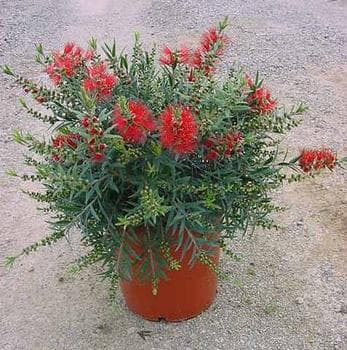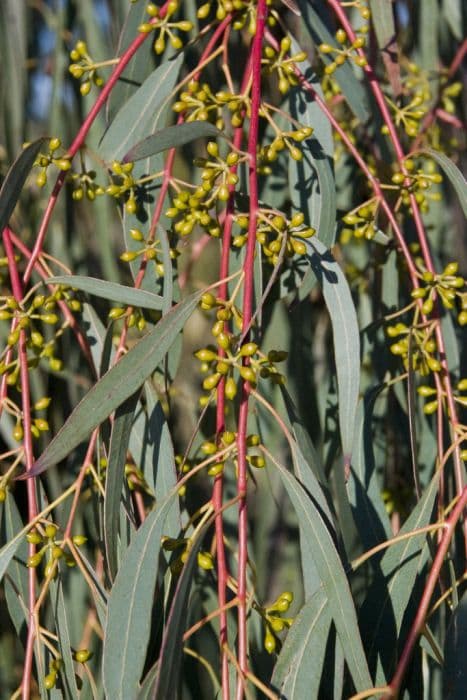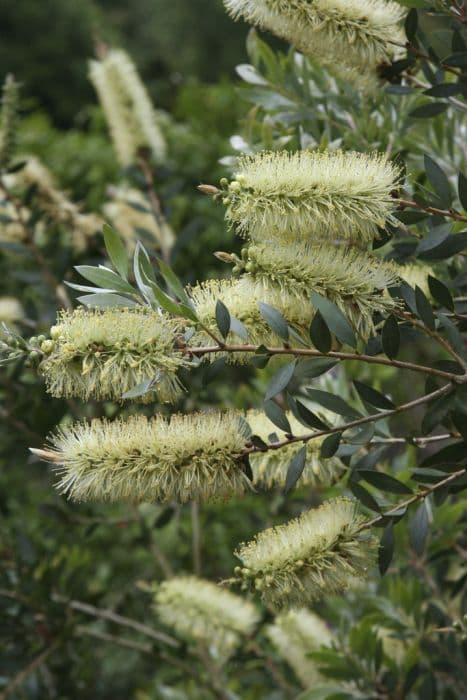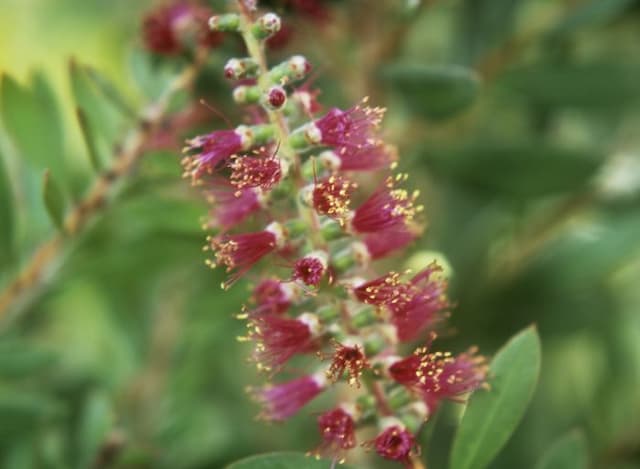Chilean Guava Ugni molinae

ABOUT
Ugni molinae, commonly known as Chilean guava, is an attractive evergreen shrub, featuring dark green, small, glossy leaves which are rounded in shape and grow densely along its branches. The foliage has a fragrant, spicy scent when crushed. It bears delicate white or slightly pink, bell-shaped flowers that have a soft, sweet aroma. Following its flowering stage, the Chilean guava produces edible berries that are about the size of blueberries, typically red or purplish in color when ripe. These berries are highly aromatic and offer a sweet, unique flavor that has been likened to a mix of wild strawberries and pink guava. The overall presentation of the Chilean guava is that of a lush, ornamental plant, with a tendency to develop a bushy appearance, often used in gardens for its attractive foliage, fragrant flowers, and tasty fruit.
About this plant
 Names
NamesFamily
Myrtaceae
Synonyms
Chilean Guava, Strawberry Myrtle, Murta, Murtilla, Uñi, Ugniberry
Common names
Eugenia ugni, Myrtus ugni, Ugni candida, Ugni goudotiana, Ugni molinae var. nanum, Ugni philippii, Ugni poeppigii.
 Toxicity
ToxicityTo humans
Ugni molinae, commonly known as Chilean guava, is not considered toxic to humans. In fact, the berries of the Chilean guava plant are edible and are often used in various culinary applications, such as making jams or eating fresh. There is no significant evidence of toxicity or adverse consequences from ingesting the fruits or other parts of this plant.
To pets
The Chilean guava (Ugni molinae) is also not known to be toxic to pets. It is generally safe when pets consume the berries; however, it is always prudent to introduce any new food to an animal's diet in moderation, as individual animals may have unique sensitivities or allergic reactions. There is no widely documented toxicity or dangerous symptoms related to pets consuming parts of the Chilean guava plant.
 Characteristics
CharacteristicsLife cycle
Perennials
Foliage type
Evergreen
Color of leaves
Green
Flower color
Pink
Height
3-6 feet (0.9-1.8 meters)
Spread
3-6 feet (0.9-1.8 meters)
Plant type
Shrub
Hardiness zones
8
Native area
Chile
Benefits
 General Benefits
General Benefits- Edible Fruit: Ugni molinae, commonly known as Chilean guava, produces small, edible berries that are sweet and aromatic, enjoyed fresh or in various culinary applications.
- Ornamental Value: With its attractive evergreen foliage, pink, bell-shaped flowers, and reddish-purple berries, the Chilean guava is a popular choice for garden ornamentation.
- Habitat for Wildlife: The plant provides a source of food and shelter for various birds and insects, contributing to local biodiversity.
- Cultural Significance: In its native range, Chilean guava holds cultural importance and is often used in traditional celebrations and foods.
- Low Maintenance: Once established, Chilean guava is quite hardy and requires minimal care, making it suitable for gardeners of all skill levels.
- Drought Tolerance: The plant is relatively drought-resistant, which is advantageous in arid climates or for water-wise gardening practices.
 Medical Properties
Medical Properties- Antioxidant: Ugni molinae, commonly known as Chilean guava, contains antioxidants which may help neutralize harmful free radicals in the body.
- Anti-inflammatory: Compounds in Chilean guava may exhibit anti-inflammatory properties, potentially contributing to reducing inflammation.
- Antimicrobial: Chilean guava has been reported to possess antimicrobial activity, which may help in fighting certain bacterial infections.
- Analgesic properties: Though not widely recognized, there is some indication that Ugni molinae might have pain-relieving properties.
 Air-purifying Qualities
Air-purifying QualitiesThis plant is not specifically known for air purifying qualities.
 Other Uses
Other Uses- Ugni molinae, commonly known as Chilean guava, can be used in ornamental topiary, as its dense foliage can be trimmed into various shapes for aesthetic garden designs.
- The wood of the Chilean guava is dense and fine-grained, making it suitable for crafting small, decorative objects or inlays in woodworking.
- In landscape designing, Chilean guava can be used as a living fence or hedge, providing both privacy and a windbreak for more delicate plants.
- The attractive flowers and fruits of the Chilean guava make it a useful plant for attracting bees and butterflies, supporting biodiversity in gardens.
- The essential oil from the leaves of the Chilean guava can be used in perfumery for its unique, spicy fragrance.
- Chilean guava can be incorporated into bonsai culture, appreciated for its small leaves and potential for miniature fruiting indoors.
- During the festive season, its bright red fruits and glossy green leaves make the Chilean guava a natural choice for holiday decorations.
- The compact growth habit of the Chilean guava makes it an ideal candidate for container gardening in urban and small spaces.
- Due to its attractive foliage, Chilean guava can be used in floral arrangements as a lasting and fragrant green filler.
- The fallen fruit of the Chilean guava can be collected and used as a natural dye, providing shades of pink and purple for fabrics or crafts.
Interesting Facts
 Feng Shui
Feng ShuiThe Chilean guava is not used in Feng Shui practice.
 Zodiac Sign Compitability
Zodiac Sign CompitabilityThe Chilean guava is not used in astrology practice.
 Plant Symbolism
Plant Symbolism- Tradition: The Ugni molinae, commonly known as Chilean guava, has been traditionally used by indigenous Mapuche people, symbolizing a deep connection with local customs and traditional uses.
- Endurance: Native to the central and southern regions of Chile and parts of Western Argentina, the Chilean guava thrives in tough conditions, representing resilience and the ability to endure difficult environments.
- Sweetness: With its sweet, aromatic berries, the Chilean guava symbolizes the sweetness of nature, pleasure, and indulgence, often reminding us to enjoy the simple, natural joys of life.
- Rarity: Because of its unique flavor and limited growing region, the Chilean guava can also symbolize rarity and exclusivity, a treasure that is sought after by those who appreciate its distinct qualities.
 Water
WaterThe Chilean Guava, or Ugni molinae, should be watered thoroughly, ensuring that the water reaches deep into the soil to encourage proper root development. Water the plant when the top inch of soil feels dry to the touch, approximately once a week, but this frequency may need to increase during hot, dry periods. Provide about one to two gallons of water to moisten the soil evenly, and make sure the plant has good drainage to prevent waterlogging. In winter, reduce watering to every other week or less, depending on the plant's environment and humidity levels, as the plant's water requirements decrease during this period of dormancy.
 Light
LightThe Chilean Guava thrives in full sun to partial shade conditions. It prefers a spot that receives several hours of direct sunlight daily but is protected from the harsh afternoon sun, especially in hotter climates. An eastern or western exposure with dappled sunlight is ideal, ensuring the plant gets the light it needs without the risk of leaf burn.
 Temperature
TemperatureChilean Guava can withstand a range of temperatures but performs best when the temperature stays between 50°F and 85°F. It can survive temperatures as low as 20°F but should be protected from frost, which can be damaging. The ideal growing conditions are mild, without extreme heat or cold, which is why it's suitable for USDA zones 8-10.
 Pruning
PruningPruning the Chilean Guava is important for maintaining a healthy and productive plant. It should be pruned to remove dead or damaged branches, to shape the plant, and to encourage new growth and better air circulation. The best time for pruning is in late winter or early spring before new growth begins. Prune lightly, aiming to cut back no more than one-third of the plant's size to keep it thriving.
 Cleaning
CleaningAs needed
 Soil
SoilThe Chilean Guava requires well-drained, fertile soil with a peat moss base. A pH of 5.5 to 6.5 is ideal, and you can create a mix with equal parts peat, pine bark, and perlite or coarse sand to ensure good drainage and aeration. Regular monitoring of soil pH is recommended to maintain these conditions for optimal growth.
 Repotting
RepottingChilean Guava should be repotted every two to three years or when it becomes root-bound. It's best to repot in the spring, just before the growing season begins, using the recommended soil mix to support the plant's nutritional requirements and growth.
 Humidity & Misting
Humidity & MistingChilean Guava thrives in moderate to high humidity levels, ideally between 50% and 70%. In dry environments, increasing humidity through the use of a humidifier, pebble trays, or regular misting can help keep the plant healthy and prevent stress.
 Suitable locations
Suitable locationsIndoor
Provide bright, indirect light and keep in a humid spot.
Outdoor
Plant in well-draining soil, a sunny or part-shaded area.
Hardiness zone
9-10 USDA
 Life cycle
Life cycleCommonly known as the Chilean guava, Ugni molinae starts its life cycle with seed germination, which occurs in moist, well-drained soil conditions after stratification to break seed dormancy. The seedlings then develop into juvenile plants, where they grow true leaves and establish a root system. As they mature into adult plants, they begin to develop woody stems and a bushy form, producing glossy, evergreen leaves. The Chilean guava flowers in spring or early summer, featuring small, bell-shaped, white or pale pink fragrant flowers that attract pollinators. Following pollination, the plant bears small, red, and purple edible berries, which ripen during late summer and fall and can aid in seed dispersal. Finally, Ugni molinae enters a dormant phase in the colder months, slowing its growth and conserving resources to complete the cycle again with the return of favorable conditions.
 Propogation
PropogationPropogation time
Spring to summer
The Chilean guava (Ugni molinae) can be propagated most effectively through semi-hardwood cuttings, which is a popular method among gardeners. This involves taking cuttings from the current season’s growth, ensuring each cutting is approximately 4 to 6 inches (about 10 to 15 centimeters) long, and contains several leaf nodes. The ideal time for this is late summer, as this ensures the cutting has somewhat mature wood. After the cutting is taken, the lower leaves are removed, and the cut end may be dipped in rooting hormone powder to encourage root development. The cutting is then planted in a well-draining soil mix, and kept moist but not overly wet, to prevent rot. It's important to provide a warm environment and maintain high humidity around the cutting, often achieved by placing a plastic bag or a propagator over the pot. Roots usually develop within a few weeks, after which the new Chilean guava plant can be gradually acclimated to less humid conditions before being planted out.









